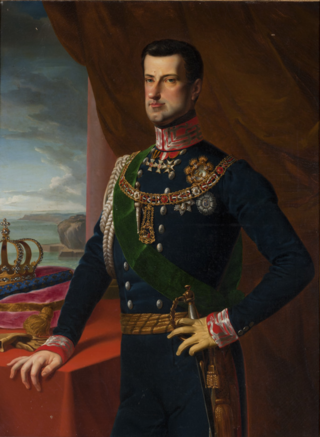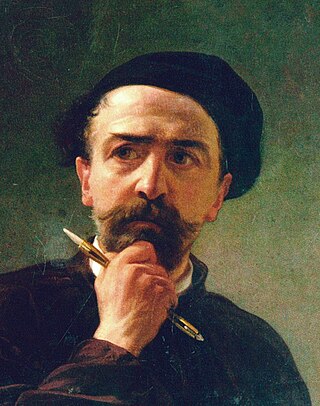This article relies largely or entirely on a single source .(August 2023) |

Giovanni Marghinotti (7 January 1798, Cagliari - 20 January 1865, Cagliari) was an Italian painter in the Neoclassical style.
This article relies largely or entirely on a single source .(August 2023) |

Giovanni Marghinotti (7 January 1798, Cagliari - 20 January 1865, Cagliari) was an Italian painter in the Neoclassical style.
His father Vincenzo was a craftsman, originally from Trapani, who worked hard to provide his four sons with professional educations. His brothers became a Jesuit priest, an engineer, and a lawyer. He was launched on an artistic career when his talent was noticed by Stefano Manca , the second Marquis of Villahermosa. Through the Marquis' influence, he obtained a Royal Patent that enabled him to attend the French Academy in Rome, beginning in 1819. [1] His primary instructor there was Jean-Baptiste Wicar. He also studied with Gaspare Landi.
He married Felicita Puccini, from Ferentino, in 1825. [1] Four years later, he had his first exhibition, in Turin. That same year, he received his first major commission: a huge allegorical canvas of King Charles Felix of Sardinia as a protector of the arts, for the Town Hall in Cagliari. In 1834, he decided to return to his home town and open a studio. Over the next decade, he received numerous commissions from royal and ecclesiastical authorities, which included large canvases for the cathedral there, as well as ones in Ozieri, Sassari and Oristano. [1]
In 1842, he was appointed an honorary member of the Accademia Albertina in Turin. Two years later, he was named a "Virtuoso of Merit" at the Accademia dei Virtuosi al Pantheon in Rome and, in 1845, became a court painter for King Charles Albert. The following year, he was awarded a chair in drawing at the Albertina, which led him to live in Turin for ten years. There, he made contacts with the Spanish Royal Court and, in 1852, was named a Knight in the Order of Charles III. [1]
A reorganization at the Albertina led to his retirement from there in 1856. Due to the possibility of armed conflict with Austria, he decided to return to Cagliari and reestablish his old contacts. This was not a popular decision with his family, as his son Angelo was about to begin a career as a painter in Turin. [1] Attempts to create Cagliari's first painting and drawing school were unsuccessful, but he became a popular portrait painter for the nobility. He died there, shortly after his sixty-seventh birthday.

Victor Emmanuel I was the Duke of Savoy, King of Sardinia and ruler of the Savoyard states from 4 June 1802 until his reign ended in 1821 upon abdication due to a liberal revolution. Shortly thereafter, his brother Charles Felix ascended the throne as the new King of Sardinia. Victor Emmanuel was the son of King Victor Amadeus III of Sardinia and his wife, Maria Antonia Ferdinanda of Spain. In 1789, he married Maria Theresa of Austria-Este, with whom he had seven children, including the future Empress of Austria.

Charles Felix was the King of Sardinia and ruler of the Savoyard states from 12 March 1821 until his death in 1831. He was the last male-line member of the House of Savoy that started with Victor Amadeus I of Savoy, and caused the line of Victor Amadeus I's younger brother Thomas Francis, Prince of Carignano to seize the throne after Felix's death.

Charles Albert was the King of Sardinia and ruler of the Savoyard state from 27 April 1831 until his abdication in 1849. His name is bound up with the first Italian constitution, the Albertine Statute, and with the First Italian War of Independence (1848–1849).

Giovanni Fattori was an Italian artist, one of the leaders of the group known as the Macchiaioli. He was initially a painter of historical themes and military subjects. In his middle years, inspired by the Barbizon school, he became one of the leading Italian plein-airists, painting landscapes, rural scenes, and scenes of military life. After 1884, he devoted much energy to etching.

Enrico Gamba was an Italian painter of genre scenes, period pieces and a few portraits.

Leonardo Bistolfi was an Italian sculptor and an important exponent of Italian Symbolism.

Carlo Arienti was an Italian painter; known primarily for historical and Biblical scenes.

Giovanni Battista Biscarra or Jean-Baptiste Biscarra was an Italian painter, sculptor and lithographer. He principally painted historical and religious subjects and royal portraits.

Antonio Giacomo Caimi was an Italian portrait painter, author, and professor at the Brera Academy.

The Kingdom of Sardinia, also referred to as the Kingdom ofSardinia-Piedmont or Piedmont-Sardinia as a composite state during the Savoyard period, was a country in Southern Europe from the late 13th until the mid-19th century.

Maria Anna of Savoy was a Princess of Savoy by birth and Duchess of Chablais by her marriage to her uncle, Prince Benedetto, Duke of Chablais.

Giacomo Grosso was an Italian painter.

Bartolomeo Giuliano was an Italian painter; primarily of portraits and genre scenes.

The Accademia Albertina di Belle Arti is an institution of higher education in Turin, Italy

Francesco Podesti was an Italian painter, active in a Romantic style. Together with Francesco Hayez and Giuseppe Bezzuoli, he is considered one of the greatest Italian painters of the first half of the 19th century. He was prolific in his large canvases on historical subjects. He is best known for his fresco work, including those in the Hall of the Immacolata in the Vatican Museum.

Angelo Boucheron was an Italian painter and engraver.

Carlo Felice Biscarra was an Italian painter and art critic.

Francesco Gamba was an Italian painter, mainly of seascapes.

Giacomo Berger or Jacques Berger was a French-Italian painter, active in a Neoclassical style, depicting historical subjects and portraits.

Giovanni Battista Arnaud was an Italian painter of frescoes. He mastered as well, the chiaroscuro technique. His work can be found in many churches, palaces and public buildings in different regions of the north of Italy. As well in some churches of France and England. He is also recognized as a great portraitist.
![]() Media related to Giovanni Marghinotti at Wikimedia Commons
Media related to Giovanni Marghinotti at Wikimedia Commons